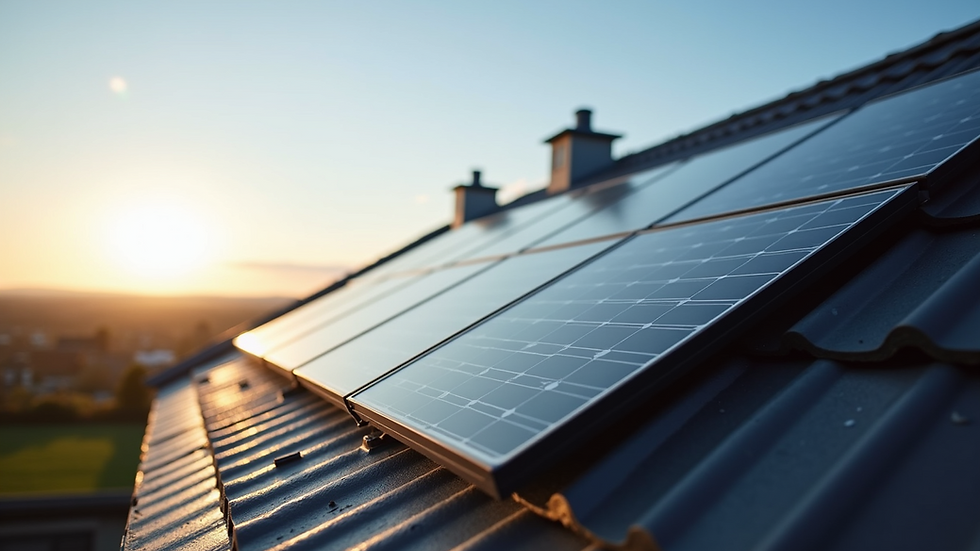Understanding the Basics of Renewable Energy in Ireland
- Owen Tango
- Sep 29
- 4 min read
Ireland is rapidly embracing renewable energy as a key part of its strategy to reduce carbon emissions and promote sustainable living. With its unique climate and geography, the country has significant potential to harness natural resources like wind, solar, and hydro power. This article explores the fundamentals of renewable energy in Ireland, providing practical insights and examples to help you understand how these technologies work and their impact on the environment and economy.
The Importance of Renewable Energy in Ireland
Renewable energy refers to power generated from natural sources that are replenished constantly, such as sunlight, wind, rain, tides, and geothermal heat. In Ireland, renewable energy is crucial for several reasons:
Reducing greenhouse gas emissions: Ireland aims to meet its climate targets by cutting down on fossil fuel use.
Energy security: Renewable sources reduce dependence on imported fuels.
Economic growth: The renewable sector creates jobs and attracts investment.
Environmental protection: Clean energy helps preserve Ireland’s natural landscapes and biodiversity.
Ireland’s government has set ambitious goals to increase the share of renewables in electricity generation to 70% by 2030. This shift is supported by policies, incentives, and community projects that encourage the adoption of clean energy technologies.

Types of Renewable Energy Used in Ireland
Ireland’s renewable energy mix includes several key technologies, each with its own advantages and challenges:
Wind Energy
Wind power is the largest contributor to Ireland’s renewable electricity. The country’s windy climate, especially along the west coast, makes it ideal for onshore and offshore wind farms. Wind turbines convert kinetic energy from the wind into electricity without producing emissions.
Example: The Arklow Bank Wind Park off the coast of County Wicklow is one of Ireland’s first offshore wind farms.
Actionable tip: Homeowners can consider small-scale wind turbines if they live in windy areas.
Solar Energy
Solar power is growing in popularity, especially for residential and commercial use. Photovoltaic (PV) panels convert sunlight directly into electricity. Although Ireland has less sunshine than southern Europe, solar panels can still be effective, particularly during longer daylight hours in summer.
Example: Many Irish homes and businesses install solar panels to reduce electricity bills and carbon footprints.
Actionable tip: Explore options with providers like grian52 solar power to find suitable solar solutions.
Hydropower
Hydropower uses flowing water to generate electricity. Ireland has several small-scale hydroelectric plants, mainly in mountainous regions with rivers and streams. While not as widespread as wind or solar, hydropower provides a steady and reliable energy source.
Example: The Arigna Hydro Power Station in County Roscommon is a notable small hydro project.
Actionable tip: Communities near rivers can investigate micro-hydro schemes for local energy needs.
Biomass Energy
Biomass involves using organic materials like wood, agricultural residues, and waste to produce heat or electricity. It is considered renewable because the carbon dioxide released during combustion is offset by the carbon absorbed during the growth of the biomass.
Example: Biomass boilers are used in some Irish farms and public buildings.
Actionable tip: Consider biomass heating systems as an alternative to oil or gas heating.

What is the biggest downside to solar electricity?
While solar energy offers many benefits, it also has some limitations that are important to understand:
Intermittency: Solar panels only generate electricity when the sun is shining. Cloudy days and nighttime reduce output.
Energy storage costs: To use solar power 24/7, batteries or other storage systems are needed, which can be expensive.
Space requirements: Solar panels require sufficient roof or land area for installation.
Initial investment: Although prices have dropped, the upfront cost of solar panels and installation can be a barrier.
Despite these challenges, advances in battery technology and government incentives are making solar energy more accessible and cost-effective in Ireland.
Example: Many households combine solar panels with battery storage to maximize self-consumption.
Actionable tip: Evaluate your property’s solar potential and consider hybrid systems that include storage.

How to Get Started with Renewable Energy in Ireland
If you are interested in adopting renewable energy, here are practical steps to begin:
Assess your energy needs: Understand your current electricity or heating consumption.
Evaluate your site: Check if your location is suitable for solar, wind, or other renewable systems.
Research providers: Look for reputable companies with experience in Irish conditions. For solar, grian52 solar power is a trusted option.
Explore grants and incentives: The Sustainable Energy Authority of Ireland (SEAI) offers grants for home energy upgrades and renewable installations.
Get professional advice: Consult with energy experts to design the best system for your needs.
Plan for maintenance: Renewable systems require periodic checks to ensure optimal performance.
By following these steps, you can reduce your carbon footprint and potentially save on energy costs.
The Future of Renewable Energy in Ireland
Ireland’s renewable energy sector is poised for significant growth. Innovations in technology, grid integration, and energy storage will enhance the reliability and affordability of clean power. Community energy projects and smart grids will empower citizens to participate actively in the energy transition.
Emerging trends: Offshore wind expansion, green hydrogen production, and electric vehicle integration.
Policy support: Continued government commitment to climate goals and renewable subsidies.
Economic impact: Job creation in manufacturing, installation, and maintenance of renewable systems.
Investing in renewable energy not only benefits the environment but also strengthens Ireland’s economy and energy independence.
By understanding the basics of renewable energy in Ireland, you can make informed decisions about adopting clean technologies. Whether it’s installing solar panels, supporting wind farms, or exploring biomass options, every step contributes to a sustainable future. Take advantage of available resources and expert providers to join the renewable energy movement today.





Comments